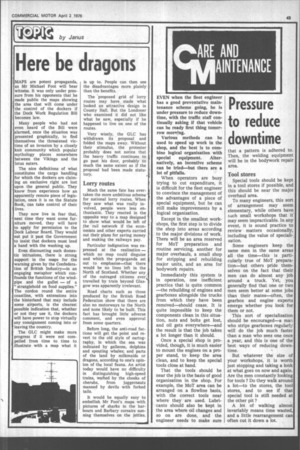Civi dE AND AINTENANCE
Page 45

If you've noticed an error in this article please click here to report it so we can fix it.
Pressure to reduce downtime
EVEN when the fleet engineer has a good preventative maintenance scheme going, he is under pressure to reduce downtime, with the traffic staff continually asking if that vehicle can be ready first thing tomorrow morning.
Various methods can be used to speed up work in the shop, and the best is to combine logical organisation with special equipment. Alternatively, an incentive scheme can be tried—but there are a lot of pitfalls.
When operators are busy trying to cut expenditure, it is difficult for the fleet engineer to convince the management of the advantages of a piece of special equipment, but he can still make improvements by a logical organisation.
Except in the smallest workshops, the first step is to divide the shop into areas according to the major divisions of work. There will be an area reserved for MoT preparation and routine servicing, another for major overhauls, a small shop for stripping and rebuilding major units, and an area for bodywork repairs.
Immediately this system is in operation, one inefficient practice that is quite common —the rebuilding of engines and gearboxes alongside the trucks from which they have been removed—should cease. It is quite impossible to keep the components clean in this situation, nuts and bolts get lost, and oil gets everywhere—and the result is that the job takes a lot longer than it should.
Once a special shop is provided, though, it is much easier to mount the engines on a proper stand, to keep the area clean, and to keep the special tools close at hand.
That the tools should be near the job is the basis of good organisation in the shop. For example, the MoT area can be arranged on a flowline basis, with the correct tools near where they are used. Lubricants should also be kept in the area where oil changes and so on are done, and the engineer needs to make sure that a pattern is adhered to. Then, the welding equipment will be in the bodywork repair area.
Tool stores
Special tools should be kept in a tool stores if possible, and this should be near the major overhaul area.
To many engineers, this sort of arrangement may seem elementary, while others have such small workshops that it may seem impracticable. In any event, it is sound practice to review matters occasionally, including the value of specialisation.
Some engineers keep the same men in the same areas all the time—this is particularly true of MoT preparation—but others pride themselves on the fact that their men can do almost any job around a truck. Yet, you generally find that one or two men seem better at some jobs than their mates—often, the gearbox and engine experts emerge whether you look for them or not.
This sort of specialisation should be encouraged—a ma., who strips gearboxes regularly will do the job much faster than a man who sees one once a year, and this is one of the best ways of reducing downtime.
But whatever the size of your workshops, it is worth just stopping and taking a look at what goes on now and again. Are the men constantly looking for tools ? Do they walk around a lot—to the stores, the tool stores, and to see if that special tooI is still needed at the other pit ?
A lot of walking almost invariably means time wasted, and a little rearrangement can often cut it down a lot.




























































































